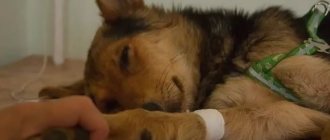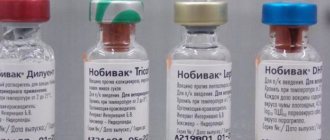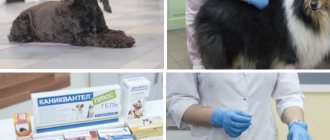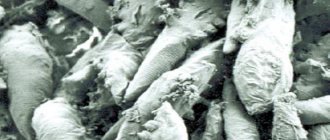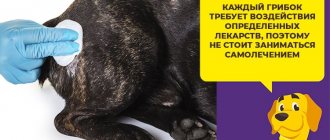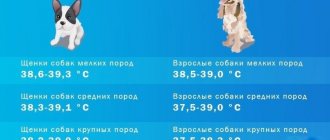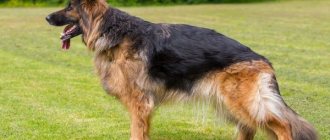Vakderm vaccine for cats
A common choice for protecting pets from dermatophytoses is the safe and effective Vakderm vaccine for cats.
Feeding on the blood of the host, lice, fleas, and ticks cause inconvenience to the animal. The animal's behavior changes, the pet loses its appetite and becomes nervous.
An infected animal's immunity decreases; wounds form at the bite sites, which become the entrance to the body for various infections and pathogenic microorganisms.
Description
Vakderm is a vaccine with a targeted effect on the treatment and prevention of dermatophytoses in animals. The product is produced in the Russian Federation and is available in the form of powder and solution for injection in ampoules (1 ml). Vakderm has a yellow-brown color. When introduced into the animal’s body, the medication develops immunity to microsporia and trichophytosis.
The vaccine is safe and has been successfully used to vaccinate both cats and other pets. The preventive effect of the drug is clearly expressed.
The drug is allowed to be used within a year from the date of release, subject to compliance with storage and transportation requirements.
The vaccine is inactivated and does not require a disinfection process
The product may be disposed of without precautions.
Action
Administration of Vakderma forms the animal's immunity to dermatophytosis, 25 - 30 days after double use with an interval of 10 - 14 days.
Post-vaccination immunity lasts for one year.
In one immunizing dose of the product, the saturation of fungal particles is approximately 30 - 50 million / cm 3.
After 10 days, you need to repeat the drug twice.
Vakderm is intended for the prevention and treatment of microsporia and trichophytosis in cats, other pets and fur-bearing animals.
It is not allowed to immunize cats:
- with elevated temperature;
- in the second half of pregnancy;
- with an unstable health condition.
Weakened and unhealthy cats should be pre-treated for fixed ailments, and only after complete recovery should they be vaccinated against dermatophytoses.
The vaccine is intended for intramuscular administration twice. Injections are given in the opposite limbs in the thigh area with an interval of 10 - 14 days according to a certain dosage:
- for cats aged 1 – 3 months, the dose is 0.5 ml;
- after 3 months of life - 1 ml for each immunization.
Subsequent preventive revaccination of pets is organized every year, twice with an interval of 10 - 14 days in accordance with the above standards.
The dry vaccine must be diluted with saline solution, a special vaccine diluent or distilled water. The medicine must be mixed until smooth.
Violation of the immunization schedule leads to a decrease in the effectiveness of immunoprophylaxis and immunotherapy for dermatophytoses.
If for some reason the next vaccination is missed, the procedure should be carried out as soon as possible.
It is strictly prohibited to use Vakderm simultaneously with other medications that can suppress the immune resistance of a vaccinated cat.
Overdose
In case of an overdose in a cat after vaccination, individual sensitivity may be recorded in the form of compactions and abscessed areas at the injection site. The cat may become sleepy.
Contraindications
Vaccination with Vakderm is not allowed if the cat has:
- heat;
- late pregnancy;
- infection;
- exacerbation phase of chronic diseases;
- a weakened state is recorded for some reason.
Immunization with this drug in cats may cause:
- the formation of minor bumps at the injection site, which resolve after 3 days;
- drowsiness that goes away after 3 days.
Warming the drug to body temperature reduces the likelihood of side effects.
You can purchase the vaccine at veterinary pharmacies. The cost of the product is about 100 rubles per dose of 1 ml.
Analogs
Before choosing and using replacement medications, you should consult your veterinarian.
Vakderm provides reliable protection against dangerous diseases and is an effective and safe remedy.
How to tell if your dog has ringworm
Many of us, having noticed a half-haired dog on the street, mistakenly believe that he is sick with ringworm. Whereas an animal can easily suffer from the same dermatitis, psoriasis or eczema. How can you tell if your dog has dermatophytosis? The disease has its own characteristic signs, namely:
- Slightly inflamed small areas of skin (at the beginning of the disease);
- Itchy skin, as a result of which the dog often painfully itches and chews itself;
- Anxiety;
- The appearance and spread of wounds on the body, which provokes the development of secondary viral or bacterial infections;
- Circular hair loss in areas affected by fungi (most often, fungi first parasitize on the animal’s face, limbs and stomach, that is, where the hair is especially short and soft);
- Deterioration of the skin condition (the skin becomes bright pink and then gray, peels, and crusts often form on it);
- Changes in claws (they become thick, lumpy);
- Increased temperature, loss of appetite, suppuration of wounds (if the dog has developed a bacterial or viral skin infection against the background of a fungal infection).
The insidiousness of the disease is that the signs of ringworm in dogs for the time being go unnoticed by the animal owner. So, you can easily not see that the dog’s skin has turned red, and the hairs have slowly begun to fall out. Unfortunately, diagnosis and treatment of an infectious skin disease is often resorted to only when the disease is in full swing. At the slightest suspicion of ringworm, it is better not to hesitate, but to immediately take your pet to the veterinary clinic, where the doctor will perform the following procedures to make the correct diagnosis:
- Blood and urine tests;
- Taking allergy samples;
- Scrapings and cultures of the affected skin on a nutrient medium;
- Fluorescent diagnostics using a Wood's lamp.
What diseases will Vakderm-F help with?
The Vakderm-F vaccine is successfully used for the prevention and treatment of the following diseases:
- Trichophytosis
is a type of ringworm caused by fungi of the genus Trichophyton. The routes of infection lie in the cat’s communication with individuals sick with trichophytosis (and their things - beds, bowls, brushes, etc.), in contact with rodents (mice, rats). Sometimes an animal can be a carrier of the fungus without external manifestations of the disease. In other cases, the owner can observe the following symptoms in his pet: the appearance of bald spots (most often first on the head, and then throughout the body), disheveled and brittle hair, dandruff, itching, inflammation on the skin, discoloration and delamination of the claw; - Microsporia
is a disease that is also called lichen. The causative agent is Microsporum fungi, which lie in wait for an animal upon contact with an infected cat during a walk (fungal spores can be found on the grass or in the soil). Sometimes even a cat that does not leave the apartment can get microsporia if, for example, the spores end up on the owner’s clothes or shoes. Like trichophytosis, microsporia can occur in a latent form, when the symptoms of the disease are not visible to the owner. In the acute form of the disease, round hairless areas of the body may be observed, broken off like cut hairs at the site of the outbreak, whitish scales on the skin, inflammation and blisters on the skin, and the appearance of ulcers.
Ringworm can affect any breed of pet, but long-haired animals (Persian, Himalayan, Angora cats) are most susceptible to the disease. At particular risk are young kittens, elderly cats and weakened individuals. But even adult animals whose health is quite strong can catch the pathogen both at home and outside. That is why the vaccine against lichen for cats “Vakderm-F” is relevant for a pet owner of any age.
Signs of ringworm
The disease develops slowly. First, spots of regular round shape appear on the skin. It looks like a trimmed area, sharply marked away from healthy tissue. It may rise above the surface of the skin.
Then the affected area becomes inflamed, redness, crusts, a small amount of ichor, and less often pus appear. The spots become oval in shape, in advanced cases they merge, forming large areas of inflammation.
Initially, lichen appears on the head, neck and legs. Sometimes the skin between the toes and paw pads are affected. Itching with microsporosis is mild or completely absent. When inflamed, the affected areas of the skin are painful.
The disease lasts for several months. Usually the dog recovers, with bald areas remaining on the fur.
Operating principle
The therapeutic effect of the drug administration is manifested in the formation of increased resistance to dermatophytosis in the animal.
Usually it is produced within 30 days after twice application with an interval of 10-14 days. The vaccine has a prolonged effect that lasts for 1 year. A single dosage of the vaccine contains approximately 30−50 million/cm3 of fungal particles.
The medicine is used without special precautions, since it is a reactogenic and completely safe drug. Injections given to animals that show signs of dermatophytoses help the symptoms of mycosis to appear more quickly in places where pathogens accumulate
They look like single or multiple mycotic lesions on the skin. 10 days after the first vaccination, the injections are given again
Injections given to animals that show signs of dermatophytosis help the symptoms of mycosis to appear more quickly in places where pathogens accumulate. They look like single or multiple mycotic lesions on the skin. 10 days after the first vaccination, the injections are given again.
Methods of personal protection when treating an animal
Dermatophytosis is an anthropozoonosis. That is, to diseases to which people and animals are susceptible. A person can become infected from an animal and another person. The infection destroys the hair and surface of the skin. Caused by microsporum and trichophyton fungi. When infected from a person, trichophytosis spores are transmitted; when infected from an animal, microsporia spores are transmitted.
The disease resulting from infection from a cat or dog lasts longer, is more difficult to cure and is more severe than that transmitted from person to person. Children and adults with weakened immune systems are at risk. Direct or indirect contact is the main route of infection.
When examining an infected cat or dog, caution must be exercised when vaccinating a healthy animal. The veterinarian carries out all manipulations in special clothing and medical gloves and a gauze mask, that is, he adheres to the usual safety measures
Types of lichen in dogs
There are several types of lichen in dogs, which differ not only in the course of the disease, methods of its treatment, but also in the causes of its occurrence.
Ringworm is the most common type of lichen in dogs, which an animal can become infected with while walking or even at home. Ringworm is caused by fungal spores that can be found in the soil (owners can easily bring them on shoes directly into the apartment), the carrier of ringworm can be a sick animal with which the dog can come into contact while walking, fungal spores can “live” on the patient’s household items animal - in its bowls, rug, collar or toys. Ringworm is a dangerous contagious disease that can quickly spread throughout a dog's body and lead to the death of the animal. Ringworm has characteristic signs: first, in small areas (20-25 mm), the hairs begin to curl as if they had been cut (hence the name - ringworm). Then the fur falls out completely and bald patches of skin that are pink, reddish or brown appear. Their contours are clear, and there are several sections at once. They cause severe itching and their number is growing noticeably. Ringworm is contagious to humans too!
Pityriasis versicolor is another type of lichen in dogs that is caused by pathogenic fungi. These yeast-like fungi can live completely painlessly on the skin and fur of dogs, without causing lesions in healthy animals with good immunity. But as soon as the immune system weakens significantly, the yeast-like fungus begins to multiply intensively in any wound on the skin. Areas with lost hair appear on the dog's body, and the skin itself becomes reddish-brown in color with different shades (this lichen is also called “multi-colored”). The lesions grow rapidly and can reach very large sizes. According to doctors, pityriasis versicolor can in rare cases become contagious in a person with a weakened immune system.
Pityriasis rosea - This type of pityriasis causes an allergic reaction in dogs to an internal infection. According to most veterinarians, pityriasis rosea is caused by the genetic predisposition of the animal against the background of a general weakening of the immune system. Unfortunately, this is a chronic condition that can occur multiple times throughout the dog's life. First, one small spot appears on the dog’s body with completely fallen hair and pink skin. Gradually, the color of the skin on the spot turns yellow, and the skin itself becomes covered with a flaky crust. Then a second spot appears nearby. Pityriasis rosea spreads quite quickly and can cover a significant area of the dog's body. Whether pityriasis rosea is contagious to humans has not yet been precisely established, but it is advisable to limit the contact of children or sick people with a dog suffering from pityriasis rosea.
Ringworm is eczema, an allergic reaction of the dog's body to food components or other substances that cause an immune response, such as medicine. Initially, the animal develops a small hairless and swollen area on its fur. The swelling is hot to the touch. Gradually it swells into a small bubble - a papule, filled with liquid. It gets wet all the time, starting to secrete pus, and increases in size. Ringworm is not contagious to humans.
Mode of application
The Vakderm drug, purchased at a veterinary pharmacy or pet store, is usually accompanied by instructions for use, which detail the vaccine administration schedule and the effect that occurs after administration of the drug. In order not to harm the health of the animal, the following rules must be observed when vaccinating:
- 10 days before vaccination, the pet must be given any anthelmintic medicine;
- before use, the dry vaccine must be diluted with a special liquid (1 milliliter of liquid per dose of the drug); for dilution, you can use saline solution, distilled water or a special liquid diluent for drugs of similar effect, which can be purchased at a veterinary pharmacy;
- the vaccine is placed intramuscularly into the soft part of the dog’s thigh, the syringe must be sterile;
- for dogs whose body weight is less than 5 kilograms, it is enough to administer 0.5 milliliters of medicine; the dose for large dogs weighing more than 5 kilograms is 1 milliliter;
- full vaccination consists of two injections: the first vaccination is placed in one thigh of the animal, and the second after 1.5-2 weeks in the other thigh;
- After vaccination, the animal must be provided with rest; the owner must free the pet from any physical activity for several days.
Owners should know that Vakderm can be used at any convenient time, regardless of the month or season (puppies can be given the first vaccination from 2 months). A veterinarian must prescribe vaccination with this drug. In order to completely protect your dog from infection with dermatophytoses, it is necessary to vaccinate every year.
What drugs are used
Domestic veterinarians use Vakderma, Microderma or Polivak TM injections to vaccinate dogs. Each of the drugs can be prescribed for both preventive and therapeutic purposes. Vaccines are produced in the form of a powder lyophilisate or solution. Active effect: no more than 1 year. The drugs differ in price and number of doses. For example:
- "Vakderm". Sold in the form of a 1 ml bottle with lyophilisate of dried fungal spores. Cost: 100 rubles.
- Microderm. The package contains 4 ampoules of inactivated spores. Cost: 360 rubles.
- "Polivak Tm". A 0.6 ml ampoule costs only 40 rubles.
All these vaccines have a similar principle of action and are analogues of each other. However, Vakderm has received the largest number of positive reviews and is used more often.
Vakderm: instructions for use
Dog owners choose this product due to its low side effects and high effectiveness against pathogenic fungi. The price of the drug varies from 95-110 rubles per ampoule. Vaccination is carried out according to the scheme given in the instructions. To avoid complications, the following rules should be strictly followed:
- carry out deworming 10 days before vaccination;
- lyophilisate of dried spores should be diluted only with saline solution;
- place the injection strictly in the hole, which can be felt in the outer part of the thigh;
- the syringe must be sterile;
- if the weight is less than 5 kg, administer only half of the drug;
- a double injection with an interval of 2 weeks is placed alternately in both thighs;
- The vaccinated animal needs rest, which means physical activity should be avoided for several days.
Self-indulgence regarding health can lead to the most dire consequences. To carry out vaccinations, you must contact only qualified specialists.
The first vaccination is allowed once the puppy reaches two months of age and has undergone a proper examination by a veterinarian. Vaccinations should be carried out annually, and then the pet will be reliably protected from trichophytosis and microsporia. The main advantage of this drug is the possibility of its use for medicinal purposes.
Purpose
Vakderm contains dermaphyte spores in an inactivated form. It can be either dry or liquid; ampoules are available in 1 milliliter sizes.
When used as a prophylaxis, the dog is found to have an incubation period for dermaphytosis. Mycoses and lesions appear at the location of the bacteria.
Then the Vakderma vaccine is administered twice. After two weeks or more, you can already notice how crusts begin to fall off from the lesions.
In such an area, fur can regrow. Immunity from dermatophytosis can generally last at least a year after vaccination.
Instructions for use
This vaccination is recommended every year. If the type is dry, then you must first dissolve it in a special solvent intended for the vaccine.
Sterile distilled water or physiological solution is also used as a solvent.
As a preventive measure, the vaccine is administered in the following dosages - if the total weight of the pet is less than five kilograms, then 0.5 ml of the vaccine. Over five kilograms one milliliter.
It is recommended to administer intramuscularly into the pet's thighs. Moreover, it must be injected first into one thigh, and after two weeks into the other. The time of year does not affect the vaccine; it can be used when needed.
Contraindications
- pregnant bitch;
- the dog is weakened;
- the pet is sick with any disease;
- The dog has a high temperature.
Small lumps with painful sensations may form at the vaccine injection sites. It's OK. After a few days everything will go away on its own.
Lumps may occur due to cold vaccine being used. It must be heated before use. Or non-sterile syringes were used.
Some pets notice a lethargic, drowsy state. Don't be alarmed, this is completely natural. Veterinarians also advise freeing your pet from physical activity after using the vaccine.
Price
The price at the time of writing is as follows - Vakderm in a 1 ml ampoule costs 88 rubles per ampoule. Find out the current cost when you need it in city pharmacies.
Description of the drug Vakderm-F
Vacderm-F is a vaccine that is used in veterinary medicine for the prevention and treatment of dermatophytoses (infectious diseases of the skin, claws and coat) in cats. The vaccine formula was developed by the Russian organization NPViZTs "Vetzverotsentr".
Vakderm-F is widely used by veterinarians to vaccinate cats.
Composition of the drug
Vakderm-F consists of the following components:
- cells of dermatophyte cultures (Trichophyton mentagrophytes, Microsporum canis and Microsporum gypseum);
- stabilizer (inactivator) formalin 0.3%;
- immunomodulator - Ribotan 0.2%.
Release form
The vaccine is a clear injection solution, colored light pink. The liquid is poured into glass containers (bottles or ampoules) with a volume of 1, 2 or 10 cm3. Each bottle is closed with a rubber stopper and a rolled metal cap. Units of the drug are packaged in cardboard boxes (10 pieces each) along with paper instructions for use.
If you are forced to replace Vakderm-F with its broad analogue, consult your veterinarian
How to properly store the vaccine
The instructions for use indicate the following storage conditions:
- the vaccine is stored and transported in a dry, dark place at a temperature of 2 to 10°C and out of the reach of children;
- The shelf life of the vaccine is 12 months from the date of release, subject to storage conditions; after the expiration date, the vaccine is not suitable;
- bottles without labels, with an expired expiration date or the integrity of the closure, with a changed color and/or consistency, or with the presence of foreign impurities must be disposed of.
The recommended storage temperature differs from usual conditions. I have had to store vaccine solutions at home many times. For this purpose, there is a separate pocket in the door of my refrigerator. A small bottle will not take up much space, but it is better to put it in the cold in a closed box. An opened box of ampoules can be sealed with tape or adhesive tape. If I have to store the vaccine for a long time, I periodically do an inspection - I inspect the solution for transparency, the presence of sediment and oxidation of the edges of the aluminum cap. The main thing in this case is not to place the drug close to the freezer.
If the manufacturer recommends storing the drug at a temperature below 10°C, then the best storage place will be the refrigerator
Treatment of lichen in dogs
What you can do at home
Medical ointments
One of the main drugs for the treatment of all types of lichen are ointments, which differ in their composition. Antifungal ointments: “Clotrimazole”, “Ichthyol ointment”, “YAM BK”, “Miconazole” - successfully fight fungi and restore the integrity of the skin.
Antibacterial, anti-inflammatory: Lecaderm, Zinc ointment, Sulfur-tar ointment - successfully fight inflammation, promote skin healing and hair growth.
Before treating the affected areas of your dog's skin with the ointment prescribed by your veterinarian, you need to treat the area around the wound. Owners must wear rubber gloves to do this. Using scissors, you need to cut off a centimeter of fur around the wound. The entire affected area of skin is treated with an antiseptic, for example, a chlorhexidine solution. If the wound is covered with a crust, they need to be soaked and removed. To do this, soak a cotton swab in soapy water and blot the crust until it softens. Then, use tweezers to remove it from the wound. The wound itself is treated with an antiseptic solution. And only then ointment is applied to the affected area.
Directions for use and dosage for cats
For preventive purposes, Vakderm is used by sequential administration of two injections with an interval of ten days to two weeks. For adult cats, a single dose of the drug is one “cube” (in some cases, depending on the weight of the animal, it is increased to one and a half or even two), for kittens under three months old - half a “cube”.
The manufacturer guarantees that 25–30 days after the second injection, the animal develops stable immunity to the causative agent of the corresponding disease, which is sufficiently preserved throughout the year.
Thus, the frequency of preventive use of the drug is two vaccines annually with a two-week interval. There are no restrictions on the time of year in this case.
Vakderma injections are administered intramuscularly into the cat's thigh (if the first injection was given in the left thigh, the second is given in the right, and vice versa).
Did you know? A shot in the thigh is the classic way to administer any vaccine. In humans, similar injections are given in the same way (sometimes in the shoulder blade, but never in the gluteal muscle). It is believed that this method is as safe as possible and contributes to the most effective immune response of the body.
A special feature of the drug is that when used as a vaccination for a healthy animal, it does not cause any signs of infection. But if the animal has already “caught the infection” by the time of the injection, even if it has not manifested itself externally, after the injection, foci of lichen will appear on its skin and fur. If this happens, the animal needs to be re-punctured not once, as usual for vaccination, but twice (in total, three injections are given with an interval of 10–14 days), after which after another two to three weeks the disease begins to recede, infected and dead skin falls off and the area is gradually covered with new hair.
Accordingly, to treat lichen, Vakderm is also usually injected three, sometimes four times.
Before injecting Vakderm into a cat, it is necessary to carry out deworming (“worming”). Deworming is done 10–14 days before vaccination, not later. We must not forget about this rule; it is universal and applies to all types of vaccinations without exception.
Important! Any vaccination, no matter how safe it may be, weakens the body’s ability to resist infection. For this reason, the animal must be completely healthy at the time of vaccination.
Otherwise, it is exposed to an additional risk of contracting the disease for which the vaccination is being carried out, or getting complications from the one from which it has already suffered. A few days after deworming are exactly what is needed in order to completely destroy any parasites that may be present in the cat’s body.
For the same reason, the drug "Vakderm" is used only if the animal is completely healthy. If a cat has an elevated body temperature (for those who don’t know, the normal temperature for a cat is from 38.0 to 39.0 ° C, kittens are half a degree higher) or symptoms of an acute disease (regardless of whether it is infectious), in addition, dermatophytosis, the use of the drug is postponed until complete recovery.
Pregnant animals and cats are not vaccinated during the period of feeding kittens.
Diagnosis and treatment of ringworm
For ringworm treatment to be successful, early diagnosis is important. The following methods are used to identify the disease:
- Diagnostics with a Wood's lamp, which emits light when exposed to it, which begins to glow green on some types of mushrooms. But only 3 types of pathogen can be detected this way. False-positive results are also possible with some medications.
- A blood and urine test reveals that the animal has a weakened immune system.
- Scraping from pathological foci and further studying it under a microscope.
- Sowing from affected areas and growing the pathogen on nutrient media. This is the most accurate method, but its only drawback is that the results will be ready only after 14 days.
Once the diagnosis of ringworm is confirmed, treatment of the disease should be comprehensive:
- local drugs are used to treat pathological lesions;
- medications are prescribed to strengthen the immune system;
- when a bacterial infection occurs, ointments containing antibiotics are prescribed.
The veterinarian must decide how to treat the disease based on the characteristics of the clinical picture.
The duration of therapy can vary from 1 to 1.5 months.
Ringworm can be treated using the following remedies:
Antifungal ointments, for example, based on clotrimazole. They are applied 2-3 times a day to pathological lesions. They need to be handled with rubber gloves and clothing, which then needs to be disinfected. Before applying the ointment, you need to cut the hair around the affected area by 2 cm. Remove crusts that come off easily; hydrogen peroxide can be used for this purpose. The cut wool and scabs must be burned, since the spores are very tenacious in the external environment and re-infection is possible. Apply the ointment to the affected area, covering a couple of centimeters of healthy skin. To prevent the animal from licking it off, they put on a muzzle or a special collar.
- Alcohol solution of iodine or salicylic acid. They can be used as an adjuvant with the permission of a veterinarian, strictly observing the dosage, as they can provoke necrosis of the treated areas. In this case, additional and long-term treatment will be required.
- Antifungal tablets. They are prescribed when there is severe damage to the animal’s body. Fluconazole-based medications may be prescribed. At the same time, hepatoprotectors are prescribed that will protect the liver.
- Antifungal shampoos, such as nizoral. But they are prescribed for large affected areas.
- Medicines that enhance immunity. Prescribing them will help to cure the dog faster; when using them, the hair grows back faster. Vitamins and immunomodulators, such as Immunofan, may be prescribed.
- When a bacterial infection occurs, antibiotics are prescribed for external and internal use.
Any medicine must be selected by a veterinarian, since each of them has its own indications, contraindications and unwanted reactions.
Dosage of the drug
Vaccination of dogs is carried out from the age of 60 days. The dose is selected according to the weight of the animal:
- if the weight is less than 5 kg of weight - a dose of 0.5 cm3 (ml);
- weight more than 5 kg - dose 1.0 cm3 (ml).
The drug is administered twice with an interval of 10-14 days. If there is only one dog, you cannot buy the vaccine packaged in 2 ml bottles to be administered once, and after 10 days another time. Once opened, the vaccine can only be used for 30 minutes.
Intramuscular injection is carried out in different limbs of the animal, in the thigh area (once in the right limb, after 10 days in the left). Revaccination is carried out after 12 months, in the same doses, twice with an interval of 10-14 days.
Before vaccination, 10-12 days before, the dog should be treated preventatively against helminth infections. For this purpose, preference is given to complex, highly effective drugs.
The vaccine is administered in compliance with aseptic and antiseptic rules. The syringe and needle must be disposable and sterile. If there are several dogs, it is allowed to draw the vaccine into one syringe, but a separate needle is used for each animal. The injection site is treated with a cotton swab moistened with a 70% concentration of ethyl alcohol solution.
Before administration, the solution should be brought to a state of uniform suspension and ensure that it is at the animal’s body temperature. To do this, the hermetically sealed bottle is lowered into a container with water, the temperature of which is 38-40 ᵒC. Leave for 2-3 minutes, shaking occasionally. Next, take out the bottle, shake well, draw it into a syringe and administer it intramuscularly to the animal.
For therapeutic purposes, the same dosage is used. The disappearance of symptoms is observed by 15-20 days after the first injection. The scabs become loose, are rejected, the epidermis is cleansed, and the growth of new hair is clearly visible. To form stable immunity, a repeat dose is administered 10-12 days after the first injection.
Vaccination of a dog with the drug "Vangard"
The American vaccine Vanguard, developed and produced by Pfizer. Forms stable immunity in the pet within 21 days from the date of administration of the drug. The drugs are well tolerated by animals regardless of age. There are two types of the drug on the Russian market: Vanguard 5/L and the Vanguard 7 vaccine. The antigenic composition is identical, the difference lies in the concentration of parvovirus antigen in one dose.
The vaccination is given to the pet by subcutaneous or intramuscular injection. Immunization is carried out according to special schemes.
- Puppies: first - at the age of 6 weeks; the second - at 9 weeks; at 12.
- Adults: if they have not been vaccinated before, the first injection, and a repeat after a week.
The drug involves revaccination once a year to maintain stable immunity to infectious pathogens. Vanguard for dogs helps prevent the development of leptospirosis, adenovirus infection, parvovirus enteritis, coronavirus, parainfluenza, infectious hepatitis, and canine distemper. Regardless of the breed and weight of the animal, the dose is 1 milliliter.
The ionVet clinic provides comprehensive and mandatory vaccinations, rabies vaccinations, and deprivation vaccinations for adult dogs and puppies. Owners can receive detailed advice and bring their animals for examination for further preventive measures.
Properties and effect of the vaccine
The drug contains cells of several types of dermatophytes. Fungi are grown on a special nutrient medium. Formalin is also present in the composition - it plays the role of an inactivator or stabilizer.
After double administration of the medicine with a two-week interval, the cat’s body develops a strong immunity against the fungus. It lasts for twelve months, so vaccination is carried out annually for prevention.
Vakderm also has healing properties, so it can prevent the development of dermatophytosis. At the same time, the drug is considered harmless, since it cannot cause the development of infection in an absolutely healthy cat. The need for vaccination is determined by a veterinarian, and he carries it out in compliance with all the rules.
Indications for use
The main purpose of the product is the prevention of various fungal infections. Vaccinations should be done every year, as ringworm and other diseases can be transmitted to people. They are especially dangerous for children, since they have not yet developed immunity.
Vakderm F can be used in the treatment of trichophytosis and microsporia identified in cats. But experts recommend using it only in the first stages of the disease. Otherwise, using the medicine will lead to a deterioration in the pet’s health.
If the drug is used for preventive purposes, it is necessary to follow the recommended regimen of use and carry out the procedure regularly. If you do not follow this rule, the effectiveness of the vaccine decreases and immunity weakens. If for some reason it was not possible to get vaccinated, you should go to the veterinarian as soon as possible.
Vakderm F
When the medicine is administered in the early stages of the disease, the symptoms become more acute: foci of infection become larger and appear in other places. Despite this, after ten to fourteen days you need to give another injection, since immunity appears only after a double injection. After three to four weeks, the crusts fall off, and the coat gradually recovers.
Contraindications
If you carefully read the instructions, you can understand that Vakderm is prohibited for use in the following cases:
- for kittens less than a month old;
- at high temperature;
- in the second half of pregnancy;
- for infectious diseases.
Also, the drug should not be given to weakened animals and cats suffering from chronic pathologies. In such situations, the underlying disease is first treated and then vaccinated.
Vakderm is prohibited for use in kittens under one month old
Sometimes cats become sensitive to the medication. This is signaled by such signs as drowsiness, apathy, and lack of appetite. Lethargy is also possible if the dosage is exceeded. In such cases, no special measures are required, since all symptoms disappear on their own. But if your pet’s health has not changed after two days, you need to go to the veterinarian.
Treatment at home
Treatment depends on the variety:
- Ringworm or eczema. First of all, they find the root cause of the disease and treat it. Then, in order to cure, the drugs Mercurius or Sulfur-3 are prescribed. The crusts are soaked and removed, and ointments (prednisolone or hydrocortisone) are applied to the affected areas of the skin.
- Pityriasis. Antifungal agents (ketoconazole, yam ointment, etc.) are applied to the affected areas of the skin. It is possible to use nizoral anti-fungal shampoo.
- Pink. This form of the disease usually goes away quickly on its own if the animal’s immunity is strengthened. Zinc liniment can be applied to the lesions, and in case of severe itching, antihistamines (suprastin, etc.) are used.
Ketoconazole, an antifungal agent
Treatment of ringworm
Animals infected with trichophytosis or microsporia are isolated in a separate room. The hair on the affected areas is cut off and destroyed.
The crusts are soaked in chlorhexidine and carefully removed.
Then a mixture of iodine tincture (mix iodine with water in a ratio of 1 to 1) and 10% salicylic acid is applied to the lesions. After treatment, anti-fungal ointments are applied (nystatin, ketoconazole, clotrimazole, etc.).
In case of a deep form, these drugs are prescribed to be taken orally in the form of tablets. If there are many lesions, the animal is washed 2-3 times a week with nizoral antifungal shampoo.
Another effective treatment method is the use of a special Vakderm vaccine. The injection is given twice intramuscularly, with an interval of 2 weeks. After administration of the vaccine, after 25-30 days, the animal develops immunity to trichophytosis and microsporia for 12 months.
It is better to burn objects that a sick dog has come into close contact with. The fabric can be thoroughly boiled with laundry soap for 15 minutes. All surfaces and clothing are treated with silvester fungus agent.
Vaccine Vakderm No. 1 (against dermatophytosis in cats, rabbits and dogs)
Contraindications and side effects
Injecting Vakderm to a dog is prohibited in the following cases:
- pregnancy;
- lactation period;
- infectious diseases.
Only healthy dogs are vaccinated. Therefore, if the temperature rises, the dog is lethargic, or is in heat, vaccination should be postponed.
Side effects may occur due to individual intolerance to the components of the product, when a cold drug is administered, or failure to comply with sterility conditions. To prevent lumps from developing into an abscess, you should:
- lubricate the bump with an antiseptic;
- draw an iodine grid;
- rub in heparin ointment;
- reduce the dog's physical activity.
If the lump has not resolved within 5 days, the veterinarian will prescribe anti-inflammatory drugs.
Composition of the drug
The drug contains exclusively natural ingredients. To produce the drug, specially weakened spores of several strains of dermatophytes are used. Obtaining the latter is still a problem for pharmacists. The fact is that they are obtained artificially, growing on special nutrient media. Fungi grow on them for a long time and poorly, which increases the cost of obtaining the drug.
To prevent the introduction of the vaccine from ending in infection of the dog, fungal spores are first neutralized with formaldehyde. Simply put, the Vakderm vaccine belongs to the “dead” category, i.e. there is no living pathogen in its composition. This means that the administration of the drug will under no circumstances lead to infection of the pet! More precisely, foci of mycoses may appear under conditions of severe overdose, but only at the injection site and they never “mutate” into a full-fledged disease.
Diagnostics
Before treatment for lichen, you need to make a correct diagnosis. In most cases, a clinical examination is sufficient. I advise you not to refuse the listed research methods offered at the clinic:
- microscopy of hairs, on which a veterinarian who has undergone special training looks for fungal spores;
- Transillumination with a Wood's lamp reveals micromycetes by a green glow;
- blood and urine tests allow you to assess the general condition of the pet;
- inoculation on a nutrient medium to identify the pathogen.
